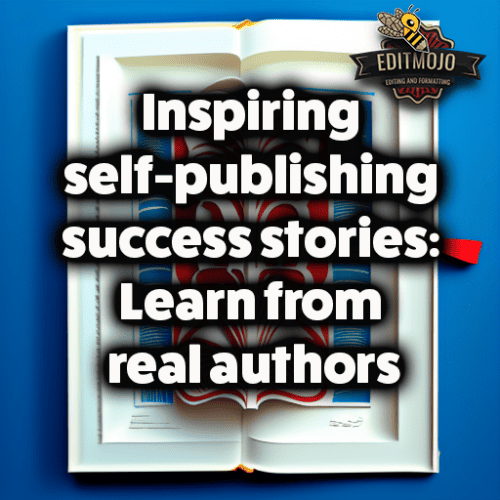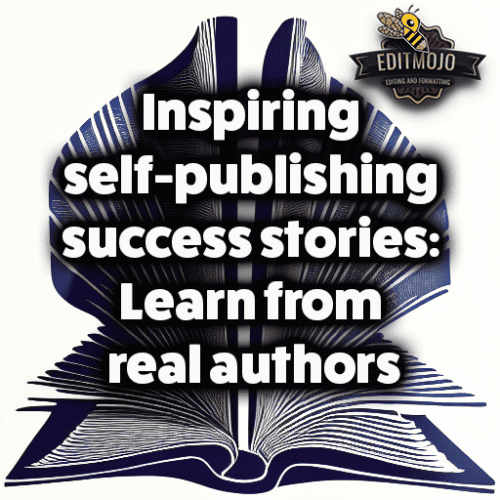Inspiring self-publishing success stories: Learn from real authors
Inspiring self-publishing success stories: Learn from real authors. In recent years, the world of publishing has witnessed a quiet but powerful revolution. Self-publishing, once a niche avenue for writers, has broken into the mainstream, shaping new pathways for authors and readers alike. This article embarks on a journey to explore real-life success stories from the self-publishing world, offering you inspiration, insights, and tangible learnings.
Key Takeaways Table
| Takeaway | Details |
|---|---|
| Self-Publishing Evolution | The self-publishing industry has dramatically evolved from the realm of vanity presses to digital platforms, offering more control and potential profit to authors. |
| Inspirational Stories | Authors like Andy Weir, E.L. James, Hugh Howey, and Amanda Hocking have achieved extraordinary success through self-publishing, proving that it can lead to results on par with traditional publishing. |
| Key Learnings | Persistence, innovation in marketing, embracing technology, and ensuring quality through professional editing and cover design are critical factors for success in self-publishing. |
| Practical Steps | Writing a compelling story, building an online presence, professional editing, understanding your audience, and innovative promotion are vital steps towards self-publishing success. |
| Future of Self-Publishing | The continuous growth of digital platforms offers more opportunities for authors, although it also introduces new challenges. It’s an exciting path full of potential rewards for those willing to persist and innovate. |
The Evolution of Self-Publishing
Once the realm of the vanity press, self-publishing has evolved significantly over the years. The traditional image of self-published authors laboriously distributing their own books has been replaced by a new era of digital platforms and online marketing. The introduction of services like Amazon’s Kindle Direct Publishing and Smashwords has empowered authors with the tools to take publishing into their own hands.
This revolution is not a silent one. Data from Bowker, the official ISBN agency in the United States, showed an almost 40% increase in self-published titles in 2018 alone, signaling the growing popularity of this publishing route.

The Power of Self-Publishing: Benefits and Challenges
Control and potential profits are two significant benefits that make self-publishing an attractive option for authors. However, it is not a path devoid of challenges. For self-published authors, marketing their book is often a personal mission. It requires savvy digital marketing skills, a keen understanding of the reader base, and a large amount of persistence.
Inspiring Self-Publishing Success Stories
The Extraordinary Success of “The Martian” by Andy Weir
Andy Weir’s science fiction novel, “The Martian”, offers an astonishing example of self-publishing success. Initially rejected by traditional publishers, Weir decided to publish his work on his own website, one chapter at a time. The chapters, available for free, quickly gained popularity among space exploration enthusiasts. Eventually, he published the complete book on Amazon Kindle Direct Publishing, where it took off and soared high in the bestseller charts.
Recognizing the book’s success, a traditional publisher acquired the rights, and “The Martian” was later adapted into a blockbuster movie. Weir’s journey is a powerful reminder of the potential of self-publishing, proving that it can lead to success that rivals and even surpasses that achieved through traditional channels.

E.L. James and the “Fifty Shades of Grey” Phenomenon
The case of E.L. James and her “Fifty Shades of Grey” series serves as another stellar example of self-publishing success. The books, initially published as fan fiction, were later self-published as eBooks. Rapid word-of-mouth buzz led to an unprecedented demand for the series, prompting a lucrative deal with a traditional publisher and the subsequent film adaptations.
James’ story offers a fascinating glimpse into how viral buzz can propel a self-published book into the mainstream spotlight. It also underscores the importance of online fan communities and word-of-mouth marketing in the self-publishing world.
Hugh Howey and the “Wool” series
Hugh Howey’s “Wool” series, published through Kindle Direct Publishing, became a phenomenal success, topping charts and captivating readers worldwide. Despite the book’s success, when traditional publishers approached Howey, he chose to retain his digital rights—a testament to the advantages and control provided by self-publishing.
Amanda Hocking, the ‘paranormal romance’ self-publishing sensation
Amanda Hocking’s journey is a testament to the power of persistence. After facing numerous rejections from traditional publishers, Hocking decided to self-publish her “paranormal romance” novels through Amazon’s Kindle Direct Publishing. This decision proved fruitful as her eBooks exploded in popularity, making her one of the poster children of self-publishing success.

Key Learnings from Successful Self-Published Authors
From these inspiring stories, several key learnings emerge.
Persistence is a recurring theme in these success stories. Each of these authors faced setbacks and rejections but refused to give up. Instead, they chose the self-publishing route and wrote their own success stories.
Innovation is another critical factor. These authors used innovative ways to market their books, leveraging digital platforms and the power of online communities.
Embracing technology was key to their success. They harnessed the potential of digital platforms, like Kindle Direct Publishing, to reach their readers.
Ensuring quality through professional editing and cover design also played a significant role in their stories.
Practical Steps Towards Self-Publishing Success
Drawing inspiration from these success stories, here are some practical steps for potential self-publishers:
Craft a compelling story: Writing and rewriting is a part of the process. Do not be afraid to refine and hone your story until it shines.
Build an online presence: Connect with your audience through websites, blogs, and social media. Engage them with your writing journey, creating anticipation for your work.
Professional editing and design: A well-edited book and an attractive cover can make a world of difference to your book’s success.
Understand your audience: Know who your readers are and what they want. This understanding will guide you in crafting your story and marketing your book.
Promote your book: Explore innovative ways to promote your book. Leverage social media, email marketing, and other online platforms.
Looking Forward: The Future of Self-Publishing
As we look to the future, self-publishing continues to evolve and offer new opportunities for authors. The continuous growth of digital publishing platforms offers even more avenues for authors to reach their readers.
However, with opportunities come challenges. Self-published authors must continue to innovate, experiment, and connect with their audiences in a crowded marketplace.
For those of you considering this path, remember the words of Hugh Howey: “There has never been a better time to be a writer.” Let these words encourage and inspire you on your self-publishing journey.
Conclusion (Inspiring self-publishing success stories: Learn from real authors)
The inspirational journeys of these authors are a testament to the potential of self-publishing. They not only achieved financial success but also reached millions of readers worldwide, leaving an indelible mark on the literary landscape. They remind us that with persistence, creativity, and the right use of technology, self-publishing can indeed become a dream come true.
Remember, each story written is unique, and so is each publishing journey. The path of self-publishing is a path of creative control, potential profits, and, above all, the possibility of connecting directly with your readers. It is not an easy path, but as our inspiring authors have shown, it is a path full of potential and rewards.
I would love to hear your thoughts on this topic. Have you considered self-publishing? Do you have a self-publishing success story to share? Please feel free to leave a comment below. Let’s continue the conversation and explore this exciting world of self-publishing together!
Top Five Questions and Answers Table
| Question | Answer |
|---|---|
| 1. What are some examples of successful self-published authors? | Andy Weir with “The Martian”, E.L. James with the “Fifty Shades of Grey” series, Hugh Howey with the “Wool” series, and Amanda Hocking with her paranormal romance novels are notable examples of successful self-published authors. |
| 2. What are the key learnings from successful self-published authors? | Persistence in the face of adversity, innovation in marketing and self-promotion, embracing digital platforms, and ensuring quality through professional editing and cover design are key takeaways. |
| 3. What are some practical steps towards self-publishing success? | Crafting a compelling story, building an online presence, ensuring professional editing and design, understanding your audience, and innovative promotion are crucial steps towards self-publishing success. |
| 4. What is the future of self-publishing? | The future of self-publishing looks promising with the continuous growth of digital platforms. However, authors need to continue innovating and connecting with their audiences in an increasingly crowded marketplace. |
| 5. What are the benefits of self-publishing? | Self-publishing offers authors more control over their work and potentially higher profits. It also provides the opportunity to connect directly with readers and understand their preferences better. |
